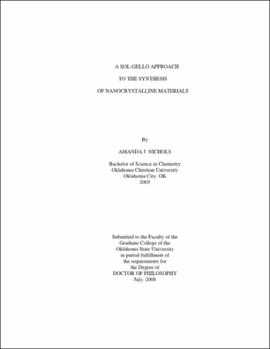| dc.contributor.advisor | Apblett, Allen | |
| dc.contributor.author | Nichols, Amanda Jayne | |
| dc.date.accessioned | 2013-11-26T08:21:28Z | |
| dc.date.available | 2013-11-26T08:21:28Z | |
| dc.date.issued | 2008-07 | |
| dc.identifier.uri | https://hdl.handle.net/11244/6466 | |
| dc.description.abstract | Scope and Method of Study: A sol-gello approach has been developed for the synthesis of nanocrystalline materials. This facile approach allows for the preparation of precursor nanoparticles that have higher reactivity at lower temperatures. Three materials have been prepared using this method: Yttrium aluminum garnet (YAG), hydroxyapatite, and spinel (MgAl2O4). The first material (YAG) can be synthesized by adding yttrium and aluminum salts to a gelling agent solution. While YAG can be prepared using any of the gelling agents (agar, gelatin, and purified gelatin), agar proved to be the most effective. For the synthesis of spinel, an ion-exchange purification method is implemented to rid the gelatin of impurities. Magnesium and aluminum salts are added to the gelatin, trapping the metal ions in a homogeneous distribution. Ammonia hydrolysis results in amorphous solids. Hydroxyapatite, a bioactive material, is formed when a calcium salt and phosphoric acid are added to the gelatin. Ammonia is used to facilitate the reaction between phosphate and calcium ions. Two purification methods were used: washing with water and using the protease trypsin to dissolve the gelatin. Both methods were successful at isolating the hydroxyapatite with some traces of gelatin left. | |
| dc.description.abstract | Findings and Conclusions: YAG is crystallized at 650 degrees C compared to the conventional preparation temperature of 1600 degrees C. Lower crystallization temperatures were achieved with an increase of agar content. The YAG crystallite size was estimated to be 11.4 nm when 30% by weight of agar was used. For the synthesis of spinel, ammonia hydrolysis results in amorphous solids. Spinel begins to crystallize as low as 420 degrees C compared to the solid state reaction temperature of 1600 degrees C. Because of the gelatin purification, only the spinel phase is present at higher temperatures. Crystallite sizes slightly decreased as the gelatin content increased. Crystallite sizes were estimated to be in the range of 1-5 nm. Nanocrystalline hydroxyapatite is formed within the gelatin matrix at room temperature estimating approximately 2.5 nm. Other important bioceramic calcium phosphate phases can be crystallized once the solid is heated. The sol-gello method is facile and applicable to the synthesis of different materials. Record low crystallization temperatures are achieved. | |
| dc.format | application/pdf | |
| dc.language | en_US | |
| dc.rights | Copyright is held by the author who has granted the Oklahoma State University Library the non-exclusive right to share this material in its institutional repository. Contact Digital Library Services at lib-dls@okstate.edu or 405-744-9161 for the permission policy on the use, reproduction or distribution of this material. | |
| dc.title | Sol-gello approach to the synthesis of nanocrystalline materials | |
| dc.contributor.committeeMember | Ford, Warren T. | |
| dc.contributor.committeeMember | Materer, Nicholas | |
| dc.contributor.committeeMember | Slaughter, LeGrande M. | |
| dc.contributor.committeeMember | Smay, James Earl | |
| osu.filename | Nichols_okstate_0664D_2834.pdf | |
| osu.accesstype | Open Access | |
| dc.type.genre | Dissertation | |
| dc.type.material | Text | |
| dc.subject.keywords | nanocrystalline | |
| dc.subject.keywords | yttrium aluminum garnet | |
| dc.subject.keywords | hydroxyapatite | |
| dc.subject.keywords | spinel | |
| dc.subject.keywords | synthesis | |
| thesis.degree.discipline | Chemistry | |
| thesis.degree.grantor | Oklahoma State University | |
